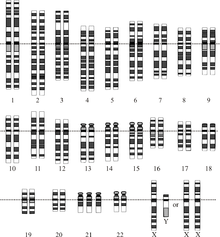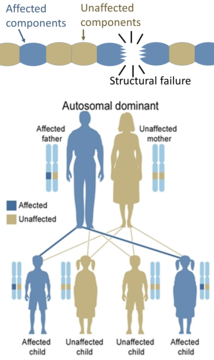Genetic disorder
| Genetic disorder | |
|---|---|
 | |
| A boy with Down syndrome, one of the most common genetic disorders | |
| Specialty | Medical genetics |

A genetic disorder is a health problem caused by one or more abnormalities in the
There are well over 6,000 known genetic disorders,
Genetic disorders are present before birth, and some genetic disorders produce
Single-gene
| Disorder prevalence (approximate) | |
|---|---|
| Autosomal dominant | |
| Familial hypercholesterolemia | 1 in 500[11] |
| Myotonic dystrophy type 1 | 1 in 2,100[12] |
Neurofibromatosis type I
|
1 in 2,500[13] |
| Hereditary spherocytosis | 1 in 5,000 |
| Marfan syndrome | 1 in 4,000[14] |
| Huntington's disease | 1 in 15,000[15] |
| Autosomal recessive | |
Sickle cell anaemia
|
1 in 625[16] |
| Cystic fibrosis | 1 in 2,000 |
| Tay–Sachs disease | 1 in 3,000 |
| Phenylketonuria | 1 in 12,000 |
| Autosomal recessive polycystic kidney disease | 1 in 20,000[17] |
| Mucopolysaccharidoses | 1 in 25,000 |
| Lysosomal acid lipase deficiency | 1 in 40,000 |
| Glycogen storage diseases | 1 in 50,000 |
| Galactosemia | 1 in 57,000 |
| X-linked | |
| Duchenne muscular dystrophy | 1 in 5,000 |
Hemophilia
|
1 in 10,000 |
| Values are for liveborn infants | |
A single-gene disorder (or monogenic disorder) is the result of a single mutated gene. Single-gene disorders can be passed on to subsequent generations in several ways. Genomic imprinting and uniparental disomy, however, may affect inheritance patterns. The divisions between recessive and dominant types are not "hard and fast", although the divisions between autosomal and X-linked types are (since the latter types are distinguished purely based on the chromosomal location of the gene). For example, the common form of dwarfism, achondroplasia, is typically considered a dominant disorder, but children with two genes for achondroplasia have a severe and usually lethal skeletal disorder, one that achondroplasics could be considered carriers for. Sickle cell anemia is also considered a recessive condition, but heterozygous carriers have increased resistance to malaria in early childhood, which could be described as a related dominant condition.[18] When a couple where one partner or both are affected or carriers of a single-gene disorder wish to have a child, they can do so through in vitro fertilization, which enables preimplantation genetic diagnosis to occur to check whether the embryo has the genetic disorder.[19]
Most congenital metabolic disorders known as inborn errors of metabolism result from single-gene defects. Many such single-gene defects can decrease the fitness of affected people and are therefore present in the population in lower frequencies compared to what would be expected based on simple probabilistic calculations.[20]
Autosomal dominant
Only one mutated copy of the gene will be necessary for a person to be affected by an autosomal dominant disorder. Each affected person usually has one affected parent.
Autosomal recessive
Two copies of the gene must be mutated for a person to be affected by an autosomal recessive disorder. An affected person usually has unaffected parents who each carry a single copy of the mutated gene and are referred to as
-
Hereditary defects inenzymesare generally inherited in an autosomal fashion because there are more non-X chromosomes than X-chromosomes, and a recessive fashion because the enzymes from the unaffected genes are generally sufficient to prevent symptoms in carriers.
-
On the other hand, hereditary defects in structural proteins (such asdominant-negativeprocess, wherein a mutated gene product adversely affects the non-mutated gene product within the same cell.
X-linked dominant

X-linked dominant disorders are caused by mutations in genes on the
X-linked recessive
X-linked recessive conditions are also caused by mutations in genes on the X chromosome. Males are much more frequently affected than females, because they only have the one X chromosome necessary for the condition to present. The chance of passing on the disorder differs between men and women. The sons of a man with an X-linked recessive disorder will not be affected (since they receive their father's Y chromosome), but his daughters will be carriers of one copy of the mutated gene. A woman who is a carrier of an X-linked recessive disorder (XRXr) has a 50% chance of having sons who are affected and a 50% chance of having daughters who are carriers of one copy of the mutated gene. X-linked recessive conditions include the serious diseases
Y-linked
Y-linked disorders are caused by mutations on the Y chromosome. These conditions may only be transmitted from the heterogametic sex (e.g. male humans) to offspring of the same sex. More simply, this means that Y-linked disorders in humans can only be passed from men to their sons; females can never be affected because they do not possess Y-allosomes.[citation needed]
Y-linked disorders are exceedingly rare but the most well-known examples typically cause infertility. Reproduction in such conditions is only possible through the circumvention of infertility by medical intervention.
Mitochondrial
This type of inheritance, also known as maternal inheritance, is the rarest and applies to the 13 genes encoded by mitochondrial DNA. Because only egg cells contribute mitochondria to the developing embryo, only mothers (who are affected) can pass on mitochondrial DNA conditions to their children. An example of this type of disorder is Leber's hereditary optic neuropathy.[30]
It is important to stress that the vast majority of
Multifactorial disorder
Genetic disorders may also be complex, multifactorial, or polygenic, meaning they are likely associated with the effects of multiple genes in combination with lifestyles and environmental factors. Multifactorial disorders include
On a pedigree, polygenic diseases do tend to "run in families", but the inheritance does not fit simple patterns as with
- asthma
- autoimmune diseases such as multiple sclerosis
- cancers
- ciliopathies
- cleft palate
- diabetes
- heart disease
- hypertension
- inflammatory bowel disease
- intellectual disability
- mood disorder
- obesity
- refractive error
- infertility
Chromosomal disorder

A chromosomal disorder is a missing, extra, or irregular portion of chromosomal DNA.[32] It can be from an atypical number of chromosomes or a structural abnormality in one or more chromosomes. An example of these disorders is Trisomy 21 (the most common form of Down syndrome), in which there is an extra copy of chromosome 21 in all cells.[33]
Diagnosis
Due to the wide range of genetic disorders that are known, diagnosis is widely varied and dependent of the disorder. Most genetic disorders are diagnosed pre-birth, at birth, or during early childhood however some, such as Huntington's disease, can escape detection until the patient begins exhibiting symptoms well into adulthood.[34]
The basic aspects of a genetic disorder rests on the inheritance of genetic material. With an in depth
Prognosis
Not all genetic disorders directly result in death; however, there are no known cures for genetic disorders. Many genetic disorders affect stages of development, such as Down syndrome, while others result in purely physical symptoms such as muscular dystrophy. Other disorders, such as Huntington's disease, show no signs until adulthood. During the active time of a genetic disorder, patients mostly rely on maintaining or slowing the degradation of quality of life and maintain patient autonomy. This includes physical therapy and pain management.
Treatment

The treatment of genetic disorders is an ongoing battle, with over 1,800 gene therapy clinical trials having been completed, are ongoing, or have been approved worldwide.[37] Despite this, most treatment options revolve around treating the symptoms of the disorders in an attempt to improve patient quality of life.
Gene therapy refers to a form of treatment where a healthy gene is introduced to a patient. This should alleviate the defect caused by a faulty gene or slow the progression of the disease. A major obstacle has been the delivery of genes to the appropriate cell, tissue, and organ affected by the disorder. Researchers have investigated how they can introduce a gene into the potentially trillions of cells that carry the defective copy. Finding an answer to this has been a roadblock between understanding the genetic disorder and correcting the genetic disorder.[38]
Epidemiology
Around 1 in 50 people are affected by a known single-gene disorder, while around 1 in 263 are affected by a
History
The earliest known genetic condition in a
See also
- FINDbase (the Frequency of Inherited Disorders database)
- Genetic epidemiology
- List of genetic disorders
- Population groups in biomedicine
- Mendelian error
References
- ^ "Genetic Disorders". Learn.Genetics. University of Utah. Archived from the original on 2022-07-15.
- PMID 23150804.
- ^ Reference GH. "What are the different ways in which a genetic condition can be inherited?". Genetics Home Reference. Archived from the original on 2020-09-27. Retrieved 2020-01-14.
- ^ a b "OMIM Gene Map Statistics". www.omim.org. Archived from the original on 2020-01-28. Retrieved 2020-01-14.
- ^ a b c d "Orphanet: About rare diseases". orpha.net. Archived from the original on 2019-12-17. Retrieved 2020-01-14.
- PMID 33350578.
- ^ PMID 11499815.
- ^ PMID 30509934.
(calculated from "1 in 17" rare disorders and "80%" of rare disorders being genetic)
- ^ Hunt JD. "An Introduction to Cancer". Genetics and Louisiana Families. lsuhsc.edu. Archived from the original on 16 January 2020.
- ^ "Prevalence and incidence of rare diseases" (PDF). Archived (PDF) from the original on 2008-11-18.
- ^ "OMIM Entry #144010 – HYPERCHOLESTEROLEMIA, FAMILIAL, 2; FCHL2". omim.org. Archived from the original on 2021-03-09. Retrieved 2019-07-01.
- PMID 33472919.
- ^ "OMIM Entry #162200 – NEUROFIBROMATOSIS, TYPE I; NF1". omim.org. Archived from the original on 2021-03-08. Retrieved 2019-07-01.
- PMID 18506019.
- S2CID 46151626.
- ^ "OMIM Entry #603903 – SICKLE CELL ANEMIA". omim.org. Archived from the original on 2021-04-26. Retrieved 2019-07-01.
- S2CID 237480065.
- PMID 21429801.
- S2CID 9382420.
- PMID 31819097.
- ^ ISBN 978-1-4292-2943-2.
- ^ "Inheritance Patterns for Single Gene Disorders". learn.genetics.utah.edu. Archived from the original on 2019-07-01. Retrieved 2019-07-01.
- ^ Wade N (29 January 2006). "Japanese Scientists Identify Ear Wax Gene". The New York Times. Archived from the original on 21 March 2023. Retrieved 20 February 2023.
- S2CID 3201966.
- ISBN 978-0-470-01617-6.
- PMID 17015291.
- PMID 19442502.
- PMID 3717163.
- ISBN 978-0-07-183301-1. Archivedfrom the original on 2023-02-20. Retrieved 2023-02-20.
- ^ Shemesh A, Sood G, Margolin E. "Leber Hereditary Optic Neuropathy (LHON)". National Library of Medicine. Retrieved 10 April 2024.
- ISBN 978-1-4160-3080-5.
- ^ "Genetic Disorders: What Are They, Types, Symptoms & Causes". Cleveland Clinic. Archived from the original on 2023-11-01. Retrieved 2023-11-01.
- ^ CDC (2023-10-10). "Facts about Down Syndrome | CDC". Centers for Disease Control and Prevention. Archived from the original on 2017-07-28. Retrieved 2023-11-01.
- PMID 28324302.
- ISBN 978-1-119-67698-0.
- ^ "Diagnostic Tests – Amniocentesis". Harvard Medical School. Archived from the original on 2008-05-16. Retrieved 2008-07-15.
- S2CID 37123019.
- S2CID 206550787.
- (PDF) from the original on 2023-06-04. Retrieved 2023-02-20.
External links
- Public Health Genomics at CDC
- OMIM — Online Mendelian Inheritance in Man, a catalog of human genes and genetic disorders
- Genetic and Rare Diseases Information Center (GARD) Office of Rare Diseases (ORD), National Institutes of Health (NIH)
- CDC’s National Center on Birth Defects and Developmental Disabilities
- Genetic Disease Information from the Human Genome Project
- Global Genes Project, Genetic and Rare Diseases Organization
- List of Genetic Disorders - Genome.gov


